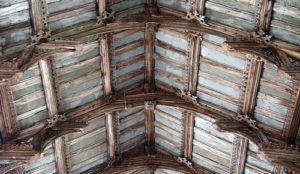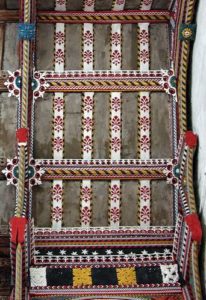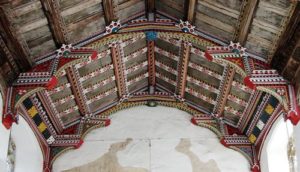I had discovered this in Rouse’s “Medieval Wall paintings” and added it to the list. Research indicated the church was open so we said a very rude word when we arrived to find the porch padlocked. The church is next to the primary school and Michael wanted to know if I had enough nerve to go and ask about a key. I did and was promptly handed one. We couldn’t get the door to unlock. The key just turned and turned without gripping. No rude word this time but a little prayer worked. We needed another to relock the door. The knack is to pull the door towards you as you turn.
After this performance Michael muttered ’it had better be worth it’. It was.
There has been a church on the site since Saxon times. The nave chancel and tower were built around 1330. The clerestory was added in the 15thC.
This is a typical Suffolk church built of rough flint with a knapped flint clerestory and large south porch. It has a battlemented square tower at the west end with an angular brick tower at the south west corner giving access to the bell chamber. At the end of the nave is a small bell cot for the sanctus bell.
The interior of the church is even better than the exterior. There was a restoration of the church in the 19thC. The Vicar was a member of the Oxford Movement and his aim was to restore the church as far as possible to its pre-Reformation state. It was certainly successful.
It is a large church, light and airy inside with huge plain glass windows in the nave flooding the church with light.
It has a double hammer beam roof. The angels were removed during the Reformation. The church has plans to replace them and there are cardboard cut out angels on the ends of the beams at the back of the church to give an impression of size and impact. It is hoped to get permission for 18 angels playing instruments and made from English oak. Fortunately the carvings between the beams have survived. At the east end of the nave and in the chancel, the roof has been re painted to give an impression of a medieval church.
Don’t miss the carved bosses in the side aisles and the angels and flowers carved between the beams. There are some medieval benches with simple poppyheads. The two back benches are the most elaborate with backs and carved ends with a lion, griffin, dog and monk praying.
The 16thC stone font at the back of the church has angels with shields and Tudor roses around the tub.
Above the chancel arch is the remains of a 15thC Doom Painting although the central part with the figure of Christ in Majesty has been lost. On the left, figures of the dead are rising from their graves on the Day of Judgement. The Righteous are received by St Peter carrying his keys and admitted into Heaven, the castellated building. The dammed are being sent to Hell on the right of the arch. At the bottom of the painting a demon is pushing a figure into Hell on a wheelbarrow.
Behind the pulpit is an 18thC painted inscription to Thomas and Dorothy Smythe, who died in 1702 and 1728.
The screen across the chancel was originally a parclose screen from the south aisle and has delicately carved tracery. The table altar with wood panelling on the east wall sits below the east window. The stained glass is a memorial to those who died in the First World War. The three central images are St Peter, Christ and St John. On the left is the inscription ‘Sursum cordata’ (lift up your hearts). On the right is ‘Gratia tibi’ (thanks be).
This is a lovely church and we are glad we found it, and managed to work the key. It is definitely worth visiting. There is parking in the village hall across the road.










